
 |
Tea Clipper |
 |
| from TeaAntiques.com | ||
| Edition One Hundred |
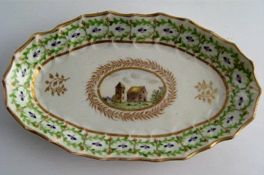
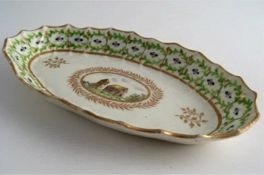 A
rare and exquisite Caughley spoon tray, made at the famous Caughley factory c1792-95.
This delightful spoon tray is beautifully 'Shanked' moulded and is of an elongated
hexagonal shape unique to the Caughley factory. It is beautifully decorated with
a central landscape painted scene. There is a green 'wreath' border.
A
rare and exquisite Caughley spoon tray, made at the famous Caughley factory c1792-95.
This delightful spoon tray is beautifully 'Shanked' moulded and is of an elongated
hexagonal shape unique to the Caughley factory. It is beautifully decorated with
a central landscape painted scene. There is a green 'wreath' border.
This particular Caughley design is discussed and illustrated in 'Chamberlain Worcester porcelain 1788-1852', by Geoffrey A. Godden (ISBN 1 85422 303 8), Plate 28 - where a teaset is shown, including a similar spoon tray to this one. It maybe the case, that this spoon tray was made at the Caughley factory and decorated at the Chamberlain's factory.
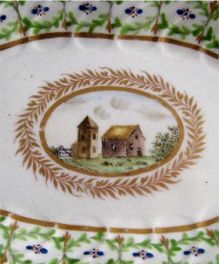
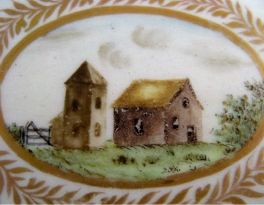
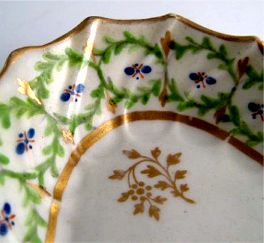
In the centre of the base of the spoon tray is an oval gilt cartouche created by a finely gilded foliate wreath with a gilded line inside which frames the delightfully painted landscape.
The landscape is a typical European style landscape and shows two buildings, one with a hipped roof, the other a tower shape. To one side of the tower building a wooden gate. The buildings are set upon a green meadow with bushes to the right hand side, This all creates a fine country scene. This is certainly a very fine spoon tray for the collector of Caughley or early English porcelain.
More details of this item and other tea related antiques can be found by visiting my web site at www.TeaAntiques.com.
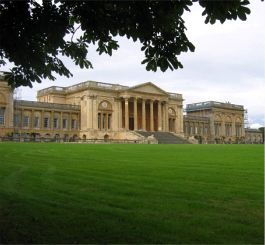 Stowe
House ranks amongst one of the finest 18th Century house in England. Sadly, from
its splendid and opulent past, it's now the home of a public school. However, architecturally
it remains a beautiful house and is set in what is one of the finest Eighteenth
century landscapes which is world famous - Stowe Landscape Garden.
Stowe
House ranks amongst one of the finest 18th Century house in England. Sadly, from
its splendid and opulent past, it's now the home of a public school. However, architecturally
it remains a beautiful house and is set in what is one of the finest Eighteenth
century landscapes which is world famous - Stowe Landscape Garden.
The house and garden, over a 300 year history, has undergone some changes, from the initial house built in 1677 with its regimented formal garden, through to the 18th century grand remodelling of the house and naturalistic landscaping of the garden by 'Capability' Brown. Most people who visit today come to marvel at this garden and its numerous stone temples, grottos and bridges, but there are guided tours of the school, which happen for 180 days throughout the year, (Check their website below for opening dates/times). In this article, I want to introduce you to the house and in the next newsletter, I will take you on a divine walk around the garden.
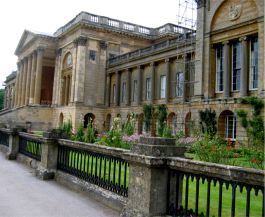
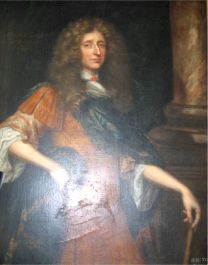 Today's
view of this magnificent house is what was largely the 18th century creation by
Viscount Cobham. Previous to this, the house, which he inherited in 1697, had been
a brick manor house designed for his father some 20 years before by Cleare, chief
master joiner to Sir Christopher Wren. Changes to the house's appearance occurred
in the 1720's to designs by Vanbrugh. Later, in the 1730's William Kent rebuilt
the North Hall and the most significant change took place in 1740's when the present
state rooms on the piano nobile, spilling into the two side wings were
designed. The house was split such that in the east wing of the house were the Ball
Room, Chapel and private apartments and in the West Wing was a huge state guest
suite.
Today's
view of this magnificent house is what was largely the 18th century creation by
Viscount Cobham. Previous to this, the house, which he inherited in 1697, had been
a brick manor house designed for his father some 20 years before by Cleare, chief
master joiner to Sir Christopher Wren. Changes to the house's appearance occurred
in the 1720's to designs by Vanbrugh. Later, in the 1730's William Kent rebuilt
the North Hall and the most significant change took place in 1740's when the present
state rooms on the piano nobile, spilling into the two side wings were
designed. The house was split such that in the east wing of the house were the Ball
Room, Chapel and private apartments and in the West Wing was a huge state guest
suite.
In 1749, Richard Grenville inherited Stowe from his uncle; he was created Earl Temple and was soon to be described as the wealthiest commoner in England. This wealth was needed for such a grand house and he had the South and North Fronts remodelled. He only just lived to see these completed and died in 1778. The contents of the house was added to by his nephew, the Marquis of Buckingham, who also added two libraries. With his lavish lifestyle of entertaining, his money began to dwindle in 1805.
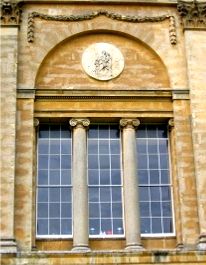
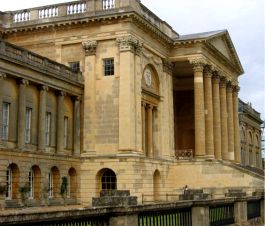
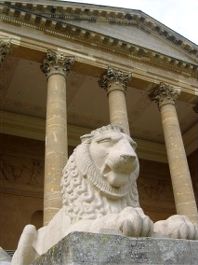
Queen Victoria was a visitor to Stowe in 1845. Three years after this, the second Duke's enormous debts meant that he was forced to sell much of the contents of the house and the house became unoccupied for over 10 years.
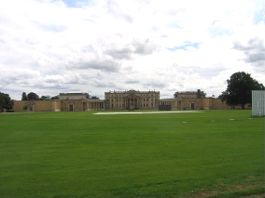 After
the death of the third and last Duke in 1889, the house was let by his daughter
to the Comte de Paris. In 1921, Stowe was bought by Harry Shaw who had intended
to give it to the nation. This was not possible without there being a money legacy
to go with the house in order to maintain it. Thus it was instead sold in 1922 to
the governors of Stowe school. Had it not been for the school taking on the house,
it would have undoubtedly been demolished - what a loss to the nation that would
have been.
After
the death of the third and last Duke in 1889, the house was let by his daughter
to the Comte de Paris. In 1921, Stowe was bought by Harry Shaw who had intended
to give it to the nation. This was not possible without there being a money legacy
to go with the house in order to maintain it. Thus it was instead sold in 1922 to
the governors of Stowe school. Had it not been for the school taking on the house,
it would have undoubtedly been demolished - what a loss to the nation that would
have been.
The house has been owned by the Stowe House Preservation Trust since 1997. It is the Preservation Trust that is undertaking a £45m restoration project to restore the house to match the marvellous work done in the gardens.
As we approach the house today, it is perhaps obviously a school rather than a home as on the front lawn ins a cricket pitch and around the main building more modern building of class rooms and dormitories. Despite these additions, one can still see the grandeur of this magnificent stone-built house shining through in all its glory.
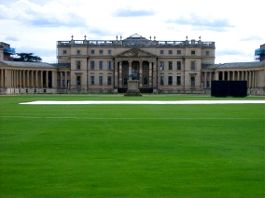
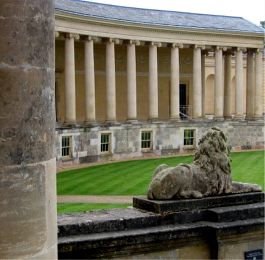
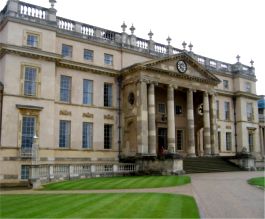
The National Trust owns and look after the Stowe Landscape garden, but the house is under the Stowe House Preservation Trust. Thus, the guided tour of the house is not carried out by the National Trust, but by the Preservation Trust and so an additional charge for this tour is required of visitors. In my opinion, it is certainly worth taking this tour, as it will help to put the landscape garden into context with the house and its owners.
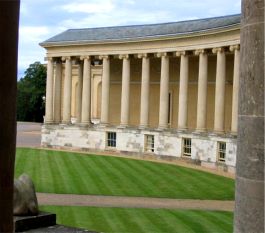
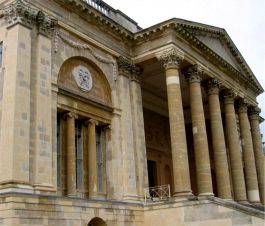 The
house was designed to be the principle temple in the richly adorned Landscape Garden.
The house is the largest private neo-classical building in the world. It has had
many famous architects making their individual mark on the house, including Vanbrugh,
Kent, Adam, Gibbs, Valdre and Soane. So impressive was it, that in its heyday it
was referred to as Stowe Palace and was visited by monarchs, poets and those in
high society.
The
house was designed to be the principle temple in the richly adorned Landscape Garden.
The house is the largest private neo-classical building in the world. It has had
many famous architects making their individual mark on the house, including Vanbrugh,
Kent, Adam, Gibbs, Valdre and Soane. So impressive was it, that in its heyday it
was referred to as Stowe Palace and was visited by monarchs, poets and those in
high society.
The tour of the house begins in the North Hall. Making your way to this, you will walk past the North front of the house. The giant North Portico was added onto Cleare's North Front of 1680 in the 1720's. At around the same time, the brickwork of the original house was covered in stucco and the corner towers added. The elegant colonnades, high screen walls and attic level were added in 1770 by Earl Temple.
Stepping into the North Hall, it is rather unassuming after the grandeur of the external architecture. It was designed by William Kent in the 1730's. The ceiling is decorated to reflect Viscount Cobham's opposition to Walpole's pacific policies. Indeed, many of the decorations, and garden ornamentations cleverly reflect the opinions on politics of the day.
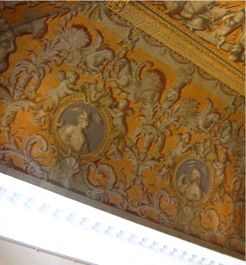
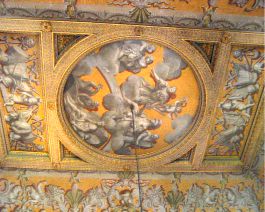
The guide who showed me round was an interesting lady who had been a matron at the school, so knew quite a lot about it as a school as well as having a great knowledge of the past history of the house and its owners. She led the way through the East Corridor and Anti-Library and into the first of the grander rooms at the Eastern end of the South Front - The Blue Room.
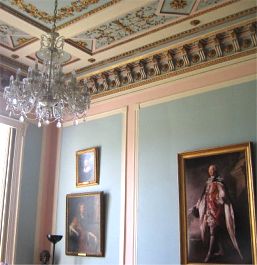
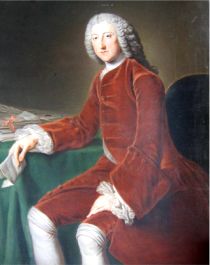 The
Blue Room has been known by many names during its history from the time it was redecorated
in 1774. It is known as the Blue Room because its walls were hung with blue silk
damask. This wall covering was sold off in 1922, leaving a relatively plain interior,
apart from the Bacchic ceiling by Valdre, some fine family portrait paintings
and some items on display in a glass cabinet. The paintings include those of the
Temple-Grenville family as well as William Pitt the elder, brother-in-law of Earl
Temple (shown right) and William Pitt the younger. In the glass cabinet are some
pieces of Worcester porcelain from the 'Stowe Service' dating from 1813 and as a
set consisted of over 200 pieces.
The
Blue Room has been known by many names during its history from the time it was redecorated
in 1774. It is known as the Blue Room because its walls were hung with blue silk
damask. This wall covering was sold off in 1922, leaving a relatively plain interior,
apart from the Bacchic ceiling by Valdre, some fine family portrait paintings
and some items on display in a glass cabinet. The paintings include those of the
Temple-Grenville family as well as William Pitt the elder, brother-in-law of Earl
Temple (shown right) and William Pitt the younger. In the glass cabinet are some
pieces of Worcester porcelain from the 'Stowe Service' dating from 1813 and as a
set consisted of over 200 pieces.
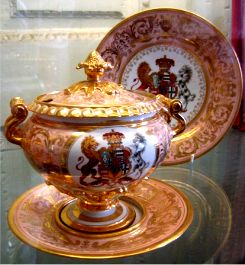
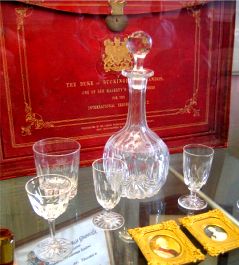
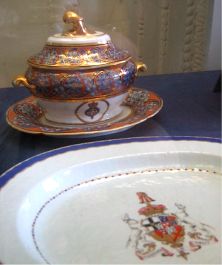
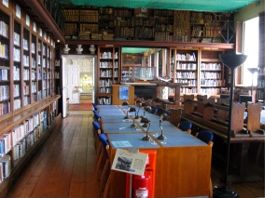
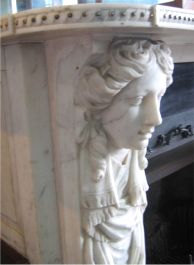 Moving
along the South Front, the next room is the Large Library. As we see this today,
it is very much a working school library with computer terminals and desks. However,
the mahogany bookcases remain; they were added by the Marquis of Buckingham in 1792,
now containing more up to date books for the school. The Large Library was created
from a Ball Room from the 1740s. It is currently waiting restoration, the ceiling
is in a state where loose plaster is falling and so in the interest of safety a
rather ugly green netting has been suspended below to catch any derbies. This is
a shame, as it does rather detract from the scale and proportion of the room.
Moving
along the South Front, the next room is the Large Library. As we see this today,
it is very much a working school library with computer terminals and desks. However,
the mahogany bookcases remain; they were added by the Marquis of Buckingham in 1792,
now containing more up to date books for the school. The Large Library was created
from a Ball Room from the 1740s. It is currently waiting restoration, the ceiling
is in a state where loose plaster is falling and so in the interest of safety a
rather ugly green netting has been suspended below to catch any derbies. This is
a shame, as it does rather detract from the scale and proportion of the room.
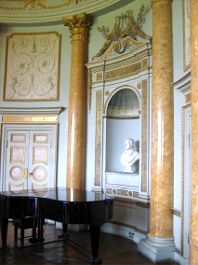
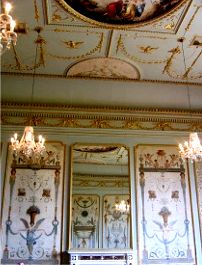 The
next room is the State Music Room, a delightful room that is beautifully decorated
with fine painted panels on the walls and ceiling. It was built as a pair of rooms,
the other being the Temple Room, in the 1770s and is a masterpiece. The walls and
ceiling decoration are in the Pompeian style, by Valdre. The neo-classical panels
of the walls are delicately painted with the theme of music and dancing, including
such panels as 'the dance of the hours'. The gilt frieze around the ceiling depict
the theme of music, ceremony and sacrifice. The ceiling has also some fine painted
panels, including a circular central one in which is also a scene entitled 'dance
of the hours', (this is a copy of the original). Rectangular panels either side
of the central medallion are decorated with 'A Bacchanalian Procession' and 'The
Revels of Sardanapalus' near the window end of the room.
The
next room is the State Music Room, a delightful room that is beautifully decorated
with fine painted panels on the walls and ceiling. It was built as a pair of rooms,
the other being the Temple Room, in the 1770s and is a masterpiece. The walls and
ceiling decoration are in the Pompeian style, by Valdre. The neo-classical panels
of the walls are delicately painted with the theme of music and dancing, including
such panels as 'the dance of the hours'. The gilt frieze around the ceiling depict
the theme of music, ceremony and sacrifice. The ceiling has also some fine painted
panels, including a circular central one in which is also a scene entitled 'dance
of the hours', (this is a copy of the original). Rectangular panels either side
of the central medallion are decorated with 'A Bacchanalian Procession' and 'The
Revels of Sardanapalus' near the window end of the room.
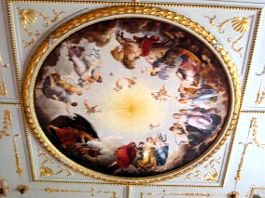
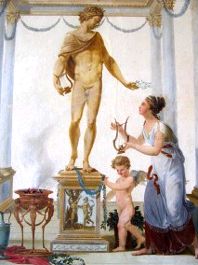
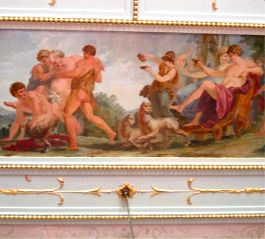
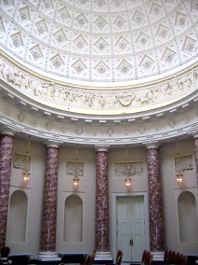
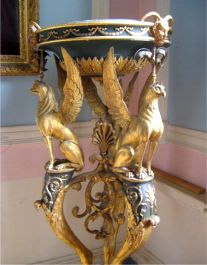 The
next room is in the centre of the South Front and is the quite magnificent and breathtaking
Marble Saloon. This mighty elliptical hall was inspired by the Pantheon in Rome.
Around the walls of the Saloon are giant order Corinthian columns, not in fact marble,
but finely painted to look like pink marble. Between these great columns are twelve
niches, now empty, but which once held antique classical statues that alas were
sold off in 1848 and four Atheniennes - two of which survive and are now in the
Blue Room (pictured right). Above the columns is an incredible sculpted frieze in
white depicting a Roman triumphant procession and contains almost 300 figures. The
frieze appears to support the vast coffered domed ceiling with a glazed oculus at
the peak lighting up the room from high above.
The
next room is in the centre of the South Front and is the quite magnificent and breathtaking
Marble Saloon. This mighty elliptical hall was inspired by the Pantheon in Rome.
Around the walls of the Saloon are giant order Corinthian columns, not in fact marble,
but finely painted to look like pink marble. Between these great columns are twelve
niches, now empty, but which once held antique classical statues that alas were
sold off in 1848 and four Atheniennes - two of which survive and are now in the
Blue Room (pictured right). Above the columns is an incredible sculpted frieze in
white depicting a Roman triumphant procession and contains almost 300 figures. The
frieze appears to support the vast coffered domed ceiling with a glazed oculus at
the peak lighting up the room from high above.
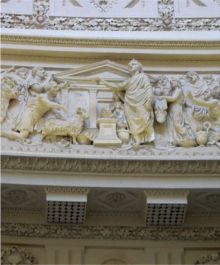
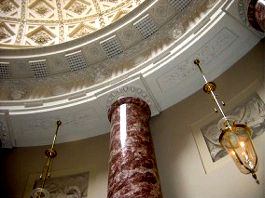
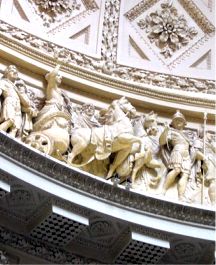
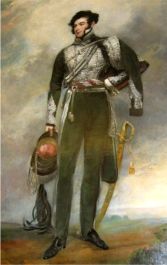 Leading
on out of the Marble Saloon brings you to the Temple Room, the other of the pair
to the State Music Room. This room was also known as the State Drawing Room from
the time it was built in 1174 until 1923. This would certainly have been a magnificent
and beautiful room in its day. At one end is a curved apse which has supporting
the curved ceiling, four Greek Corinthian columns. These columns and the delicately
decorated neo-classical ceiling are probably the work of Valdre. This room would
have contained much of the family's best furniture and paintings as a place of great
entertaining. When Queen Victoria visited the house in 1845, the room was re-arranged
and she is recorded to have said 'one of the most perfect interiors ever witnessed'.
The ceiling has been restored by the school. However, it was paid for by generous
donations from pupils' parents. The restoration included the re-gilding of the decoration.
However, due to the high cost of doing it in gold, it was settled for the less expensive
silver that we can see today. there are future restoration plans to put this right
and have the ceiling re-gilded.
Leading
on out of the Marble Saloon brings you to the Temple Room, the other of the pair
to the State Music Room. This room was also known as the State Drawing Room from
the time it was built in 1174 until 1923. This would certainly have been a magnificent
and beautiful room in its day. At one end is a curved apse which has supporting
the curved ceiling, four Greek Corinthian columns. These columns and the delicately
decorated neo-classical ceiling are probably the work of Valdre. This room would
have contained much of the family's best furniture and paintings as a place of great
entertaining. When Queen Victoria visited the house in 1845, the room was re-arranged
and she is recorded to have said 'one of the most perfect interiors ever witnessed'.
The ceiling has been restored by the school. However, it was paid for by generous
donations from pupils' parents. The restoration included the re-gilding of the decoration.
However, due to the high cost of doing it in gold, it was settled for the less expensive
silver that we can see today. there are future restoration plans to put this right
and have the ceiling re-gilded.
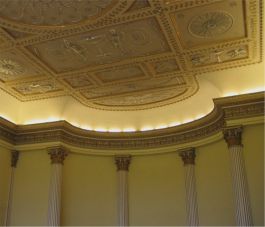
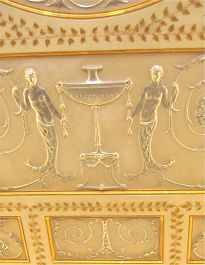
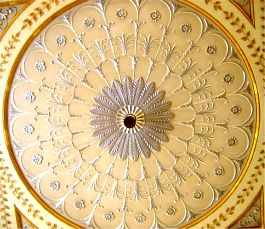
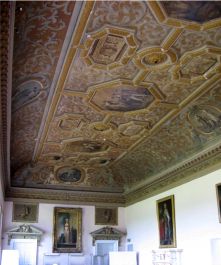
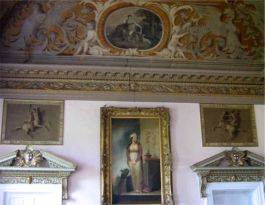 The
final room along the procession of State Rooms is the State Dining Room - now the
refectory of the school. This huge room started its life in the 1740's as the State
Gallery. This function changed over the next century due to its handy location near
to the kitchens. The richly decorated ceiling has three main octagonal panels, these
painted in the 1820's. They depict 'Venus disarming Cupid', 'Venus on her car' and
'Venus at her toilet'. Originally the room was hung with tapestries and housed a
65 foot long dining table - all sold off in the 1920s.
The
final room along the procession of State Rooms is the State Dining Room - now the
refectory of the school. This huge room started its life in the 1740's as the State
Gallery. This function changed over the next century due to its handy location near
to the kitchens. The richly decorated ceiling has three main octagonal panels, these
painted in the 1820's. They depict 'Venus disarming Cupid', 'Venus on her car' and
'Venus at her toilet'. Originally the room was hung with tapestries and housed a
65 foot long dining table - all sold off in the 1920s.
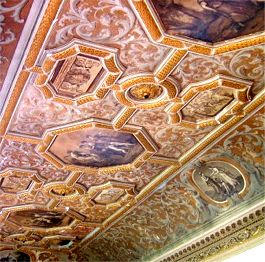
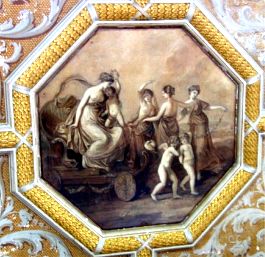
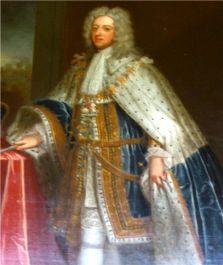
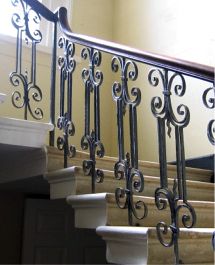
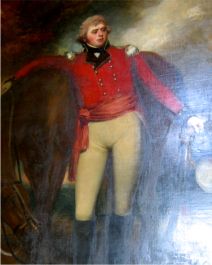 The
tour ends by taking one of the two grand staircases down to the lower floor where
there is the 'Egyptian Hall'. This was created in 1803 and forms a winter entrance
to the house. The design was much inspired following Napoleon's visit to Egypt and
is said to have been modelled on the temple at Tintyra. From here a narrow staircase
wends its way back to where we started in the North Hall and concludes the house
tour.
The
tour ends by taking one of the two grand staircases down to the lower floor where
there is the 'Egyptian Hall'. This was created in 1803 and forms a winter entrance
to the house. The design was much inspired following Napoleon's visit to Egypt and
is said to have been modelled on the temple at Tintyra. From here a narrow staircase
wends its way back to where we started in the North Hall and concludes the house
tour.
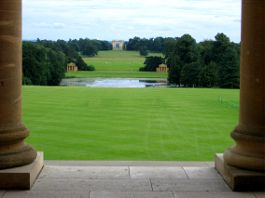
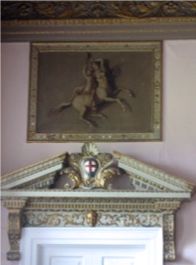
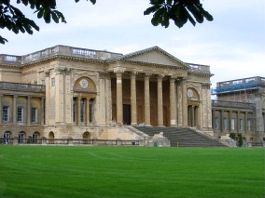
In the next issue, I will guide you round the garden, one of the best landscaped gardens in the world.
Stowe House, Stowe, Buckingham MK18 5EH Tel: +44 (0) 1280 818166 - for recorded information www.stowe.co.uk/house - Stow House Preservation TrustTo review past newsletters, just follow this link:
Past newsletters.
To subscribe to this free newsletter -
Click here